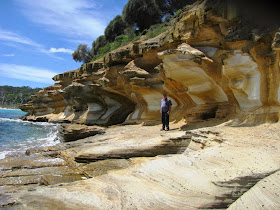The Cascades Female Factory became one of Tasmania's longest running penal institutions. It was built in 1828 and operated until 1856. It is a testament of the cruel and inhumane conditions that prisoners were created and housed in such appalling conditions. I hadn't really considered what the female convicts went through. My closest 'images' are those from book and movie "The Potato Factory" written by Bryce Courtney. This is so much worst.
Sadly previous governments had little forethought of the historical significance of many places and here is the same. The walls of the buildings may no longer stand, but that is of little difference as there are many indicators that 'point' you to where the walls and yards were.
We took a guided tour and she evoked a real compassionate understanding of the mental, physical hardship these poor women endured. That the governor of the time, ignored the advice of his engineer that this location would flood and thus be an unsuitable location for a penal colony. The governor wilfully went ahead as it was a relatively low cost alternative and thus subjected these women to work and live in damp, putrid cells for long periods often on just bread and water.
The guide tour also allowed us to visit the interior of the only existing building, the Matron's Cottage where there are some artifacts and such to be seen.
It is a tour not to be missed. You can look around the 'yards' without a tour and save a few bucks but the understanding of what the various stones/pavers mean will be lost on you and you certainly will not begin to comprehend what went on inside this female factory.
This has made a much deeper impression on me that Port Arthur did. I certainly feel that the women served time in a much harsher environment than the men on Maria Island or Port Arthur! It certainly stays with you long after you leave.
Sadly previous governments had little forethought of the historical significance of many places and here is the same. The walls of the buildings may no longer stand, but that is of little difference as there are many indicators that 'point' you to where the walls and yards were.
 |
We took a guided tour and she evoked a real compassionate understanding of the mental, physical hardship these poor women endured. That the governor of the time, ignored the advice of his engineer that this location would flood and thus be an unsuitable location for a penal colony. The governor wilfully went ahead as it was a relatively low cost alternative and thus subjected these women to work and live in damp, putrid cells for long periods often on just bread and water.
The guide tour also allowed us to visit the interior of the only existing building, the Matron's Cottage where there are some artifacts and such to be seen.
 |
| The size of the solitary confinement cells are abysmally small. |
It is a tour not to be missed. You can look around the 'yards' without a tour and save a few bucks but the understanding of what the various stones/pavers mean will be lost on you and you certainly will not begin to comprehend what went on inside this female factory.
This has made a much deeper impression on me that Port Arthur did. I certainly feel that the women served time in a much harsher environment than the men on Maria Island or Port Arthur! It certainly stays with you long after you leave.
































%2Bmini%2Bcrabs_0137d.jpg)

%2Byellow%2Blichen%2Bon%2Bthe%2Brocks_0136w.jpg)
%2Byellow%2Blichen%2Band%2Ba%2Bplant_003.jpg)










